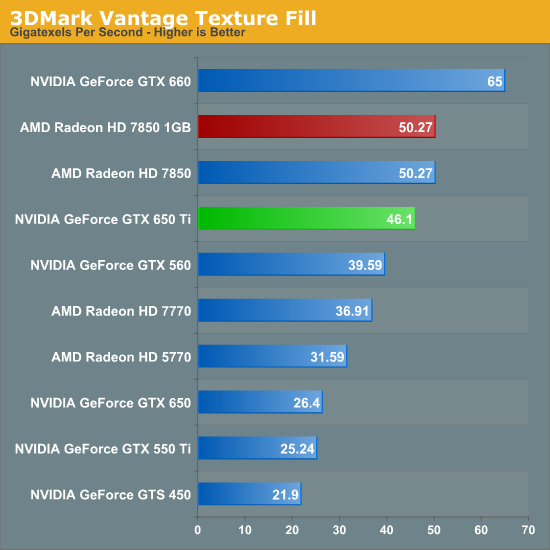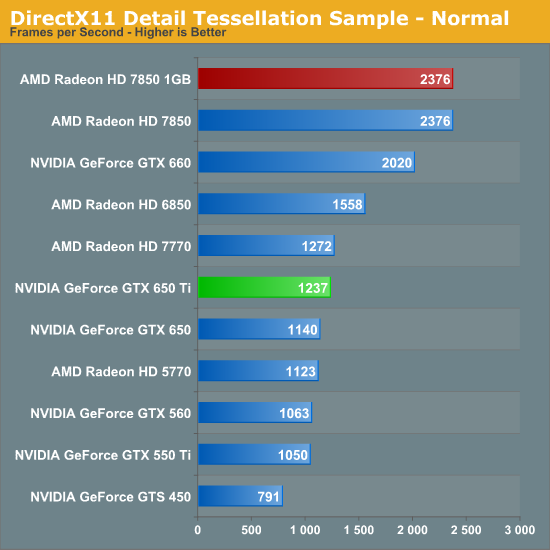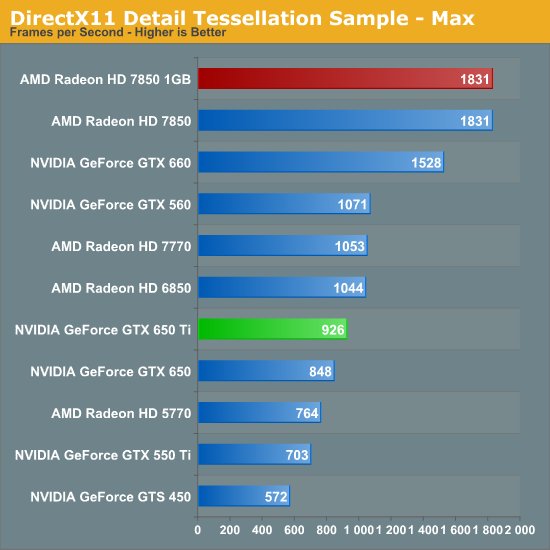The NVIDIA GeForce GTX 650 Ti Review, Feat. Gigabyte, Zotac, & EVGA
by Ryan Smith on October 9, 2012 9:00 AM ESTSynthetics
As always we’ll also take a quick look at synthetic performance to see if NVIDIA’s core configuration has had any impact on basic performance metrics. Paper specifications tell us that texture fillrate should take a decent hit with pixel fillrate takes an even larger hit; and meanwhile tessellation should hold up fairly well. We’ll start with 3DMark Vantage’s Pixel Fill test.

As expected, the GTX 650 Ti drops off a cliff compared to the GTX 660. Despite this, it does rather well compared to the GTX 650 despite the similar ROP throughput and memory bandwidth of the two cards. It can even edge out the GTX 560 in the process.

Meanwhile 3DMark Vantage’s Texture Fill test backs up our earlier texture performance expectations. The drop compared to the GTX 660 is still large, but not by nearly as much as the pixel fillrate. Having twice as many SMXes as the GTX 650 also means that it comes close to doubling the GK107 card’s performance here.
Our third theoretical test is the set of settings we use with Microsoft’s Detail Tessellation sample program out of the DX11 SDK


So much for tessellation performance holding up. This is admittedly a high pixel throughput test (we’re measuring at 1000fps+), but it’s also a very simple test that doesn’t have a great deal of overdraw. Despite the fact that the GTX 650 Ti holds on to most of GK106’s Polymorph Engines, performance drops by 40% relative to the GTX 660, which is far more in-line with the loss of ROP throughput and memory bandwidth.
Our final theoretical test is Unigine Heaven 2.5, a benchmark that straddles the line between a synthetic benchmark and a real-world benchmark as the engine is licensed but no notable DX11 games have been produced using it yet.

Despite everything else we’ve seen, Unigine results are almost exactly in the middle of the expected performance loss between shading/texturing and ROP/memory on the GTX 650 Ti. This makes it just good enough to tie the GTX 560, or surpass the GTX 550 Ti by nearly 50%.










91 Comments
View All Comments
chizow - Tuesday, October 9, 2012 - link
I guess in years past this may and probably should've been branded GTS 650Ti along with the GTS 650 (they've used GTS 250, GTS 450 etc in the past), but I know for a fact Nvidia is trying to establish GTX as its own brand for gamers.They really emphasize it with all this "Green Light" business with regard to overclocking, overvolting etc.
Blazorthon - Tuesday, October 9, 2012 - link
Nvidia has been cracking down on overvolting support, so IDK if I'd give them that much credit.Pneumothorax - Tuesday, October 9, 2012 - link
That will make the price/performance gap even worse as the 7850 is an oc beast.goinginstyle - Tuesday, October 9, 2012 - link
So why no reviews of the Asus or MSI offerings in these roundups?silverblue - Tuesday, October 9, 2012 - link
You need to be sent a card in order to review it. ;)Shadowmaster625 - Tuesday, October 9, 2012 - link
The 7850 1GB is $150. It IS is the direct competitor to the 650 ti. You can speculate all you want about the 1GB being some sort of ephemeral limiting factor, but I dont see it. All I see is that in one game, at BEYOND 1080p resolution, memory becomes a factor. But if you look at it, you can see that it is still so very close on the bell curve. I bet that if you actually tested Skyrim at 1920x1080 (not 1920x1200), there would be much less difference between 2GB and 1GB.Even 2 years from now the 7850 1GB is going to be a better performer than the 650ti. Even with the "latest and greatest" games.
Shark321 - Tuesday, October 9, 2012 - link
Where is the 7850 1GB $150?KineticHummus - Tuesday, October 9, 2012 - link
yeah wish i could fine one of those haha. pretty sure there isnt a single card for 150Marlin1975 - Tuesday, October 9, 2012 - link
How about $159 AR shipped?http://www.newegg.com/Product/Product.aspx?Item=N8...
LordanSS - Tuesday, October 9, 2012 - link
I'm a bit curious about this card's performance with PhysX enabled games.Personally, I am a 6970 owner and thus have no access to PhysX effects on games, but there are many workarounds out there where you can add a nVidia card to your machine to compute the physics.
Borderlands 2 is an example, I know of people buying (cheap) nVidia cards so they can run physics on them. Problem is that, most of the time, these guys are buying really old or cheap hardware (like GT210 or 430 cards), causing a big drop in game performance. Others using more powerful (and expensive) cards, on the other hand, experience good results.
So I'm thinking what's the cutting point for performance here. I know it's an extremely niche endeavor, but if anyone has experience or thoughts, I'd be glad to hear them.